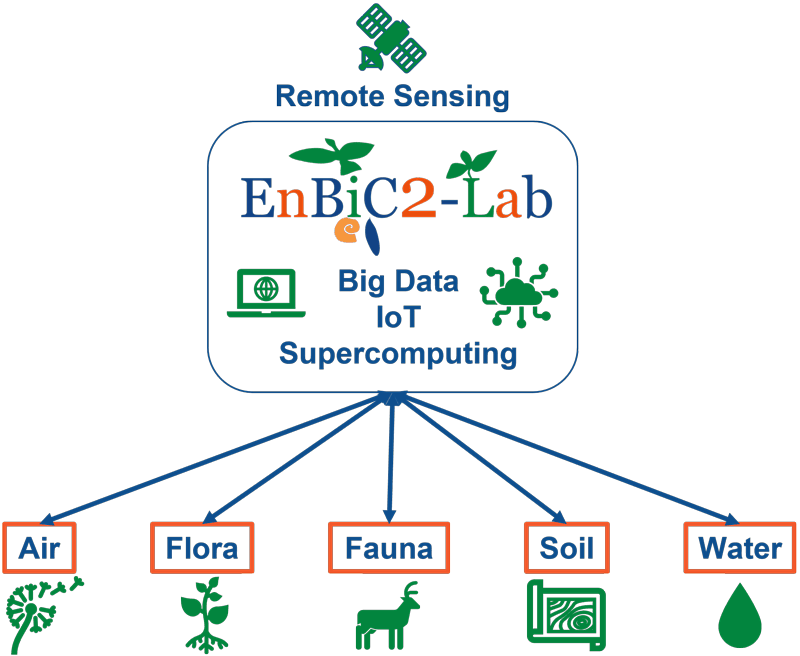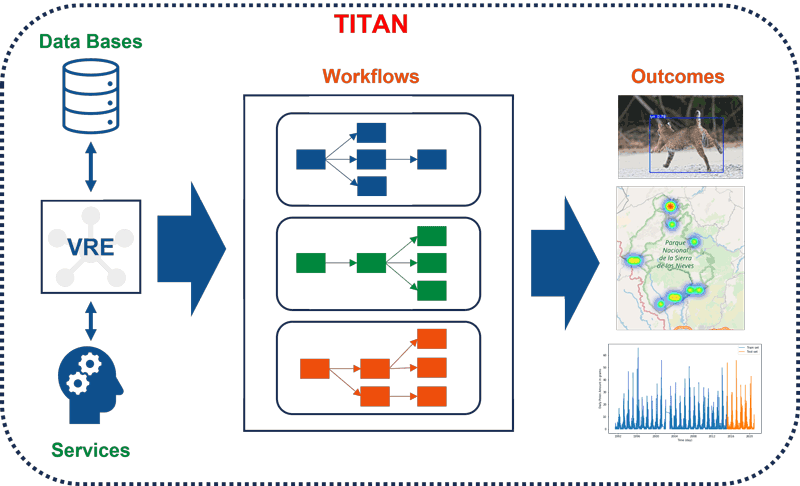by María Luisa Antequera Gómez, Cristóbal Barba González and Ismael Navas Delgado (ITIS Software, University of Málaga)
The Environmental and Biodiversity Climate Change Lab (EnBiC2-Lab) is a cutting-edge project employing virtual research environments (VREs) to comprehensively monitor and analyse climate change's effects on water, air, soil, flora and fauna aspects. EnBiC2-Lab aims to generate effective resolution strategies to enhance climate change resilience and safeguard biodiversity.
Climate change is one of humanity's most critical challenges, with far-reaching consequences for our planet's biodiversity. It disrupts ecosystems, alters species distributions and threatens the delicate balance of life on Earth. As the magnitude of climate change becomes increasingly apparent, scientists and researchers are intensifying their efforts to understand its current impacts and anticipate future repercussions. VREs have become essential tools for collaborative data collection, analysis, and information sharing. In the realm of climate change research, they significantly boost efficiency by enabling real-time data exchange and improving the quality and reliability of research findings. For instance, the integration of a web application in cataloguing flora greatly streamlines the analysis of field-collected data. VREs are pivotal in evaluating how climate change impacts the distribution of animal and plant species, thereby facilitating biodiversity conservation efforts within the European Union. This approach empowers researchers to establish links between species distribution and a variety of environmental factors, providing valuable insights into both historical trends and future projections. Consequently, the results obtained are based on high-quality data, and they can be easily shared and published through the EnBiC2-Lab platform.
The project is developed under the FEDER program, co-funded by the e-infrastructure LifeWatch ERIC, the ERDF (Spain's Pluri-regional Operative Programme 2014–2020) through the Spanish Ministry for Research and Innovation, and the University of Málaga. The comprehensive database produced by the project via toolset and VRE to monitor and analyse, enhance our understanding on factors that influence biodiversity. This VRE enables researchers to share data, collaborate on analysis and disseminate findings seamlessly. The EnBiC2-Lab project is a cutting-edge initiative addressing climate change's complexities and its effects on ecosystems and biodiversity. This includes changes in temperature and precipitation patterns affecting where groundwater replenishes, the spread of invasive species into previously inhospitable environments, and alterations in birds' migration paths and the timing of flowering seasons. Its core objective is to develop a collaborative platform based on the big data analysis platform TITAN [1], equipped with integrated tools and data, to comprehensively monitor and analyse climate change impacts from five critical perspectives: water, air, soil, flora, and fauna, as depicted in Figure 1.

Figure 1: EnBiC2-Lab project general outline. Air, flora, fauna, soil and water aspects are covered using remote sensing and big data, Internet of Things (IoT) and supercomputing approaches.
The project's choiAbies pinsapoce of pilot areas, namely Los Alcornocales Natural Park, Sierra de las Nieves National Park, and Cabo de Gata-Níjar Natural Park, demonstrate a strategic approach to climate change resilience. These areas have distinct climates, influenced by their location and altitudes. Sierra de las Nieves, with its high elevation of nearly 2000 meters, experiences cooler winters, while Cabo de Gata-Níjar has an arid and semi-desert climate. Each area also has unique biodiversity and ecology, such as cork oak forests in Los Alcornocales, volcanic landscapes in Cabo de Gata-Níjar, and pine forests with endemic species like Abies pinsapo in Sierra de las Nieves. Climate change, characterized by rising temperatures, profoundly impacts these ecosystems. It affects species distribution and migration patterns, particularly for species like the Rüppell’s vulture. Higher temperatures worsen aridity and wildfire risks, especially in hot regions like Cabo de Gata-Níjar. Changes in the water cycle disrupt precipitation patterns, contributing to desertification in already hot and dry areas. This, in turn, affects water availability, influencing flora and fauna distribution. Emblematic species like the Iberian lynx and Abies pinsapo in Sierra de las Nieves, as well as cork oak forests in Los Alcornocales, face significant threats. Data collected in Sierra de las Nieves highlights endemic species, like Abies pinsapo and Festuca indigesta, and how environmental factors, such as temperature and precipitation, impact the flora and their future trends due to climate change.
EnBiC2-Lab VRE includes data storage and integration, encompassing biological and physicochemical information from diverse sources. The VRE also facilitates automatic biodiversity classification and monitoring, which includes not only the collection of flora samples and phytosociological inventories but also the location of both alien and endemic species. For instance, Gomphocarpus fruticosus in Los Alcornocales, Castanea sativa in Sierra de las Nieves, and Nicotiana glauca in Cabo de Gata-Níjar are identified as alien species, while Quercus suber in Los Alcornocales, Abies pinsapo in Sierra de las Nieves, and Maresia nana in Cabo de Gata-Níjar are recognized as native species. Additionally, the platform supports fauna detection and tracking, further enhancing its comprehensive approach to ecosystem analysis. Moreover, these services extend to incorporating remote sensing data from satellite and drone images, allowing for accurate land-cover and land-use classification. These services allow researchers to observe the dynamics of individual organisms, the composition of communities and the overall health of ecosystems. These observations offer insights into the adaptive capacities of relevant species and the resilience of entire ecosystems in the face of changing environmental conditions.
A primary outcome of the EnBiC2-Lab project is the generation of analytic workflows (Figure 2) to allow scientists and policymakers to accurately anticipate the consequences of climate change in the chosen pilot areas and extend to other European natural areas. Effective resolution strategies can be designed using this knowledge to enhance climate change resilience. Proactive measures can be implemented to protect vulnerable species, preserve vital habitats and promote ecosystem sustainability. The designed workflows cover specific analyses of the following critical perspectives (Figure 1):
- Water: Processing and completing temperature and precipitation series, estimation of potential evapotranspiration (ETp) and effective rainfall, and 3D interpolating meteorological variables using digital elevation models (DEMs).
- Air: Analysis of pollen trends and pollen forecasting using artificial intelligence techniques.
- Soil: Automated storage of soil samples in project databases and principal component analysis of soil physicochemical features.
- Flora: Automated storage of flora and vegetation samples in project databases and analysis of plant communities and species.
- Fauna: Automatic classification of camera-trap images using artificial intelligence.

Figure 2: EnBiC2-Lab VRE structure (data bases, services and workflows) and example outcomes.
The EnBiC2-Lab project is a potential tool in the ongoing battle against climate change. By combining the power of VREs and a comprehensive approach to biodiversity and ecosystem monitoring, this initiative embodies the collaborative efforts required to tackle climate change resilience effectively. As the impacts of climate change continue to unfold, the knowledge and solutions derived from the EnBiC2-Lab project will be invaluable in safeguarding the diversity of life on Earth and building a more resilient future for all living beings.
Link:
[L1] https://enbic2lab.uma.es/
Reference:
[1] A. Benítez-Hidalgo et al., “TITAN: A knowledge-based platform for Big Data workflow management”, Knowledge-Based Systems, vol. 232, p. 107489, 2021. https://doi.org/10.1016/j.knosys.2021.107489
Please contact:
Ismael Navas Delgado, ITIS Software, University of Málaga, Spain
José Francisco Aldana Montes, ITIS Software, University of Málaga, Spain










